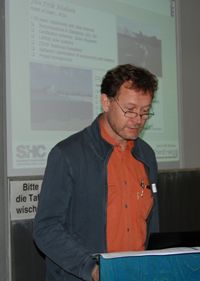Task 43: Worldwide Harmonisation of Solar Rating and Certification Procedures
April 21, 2010
Jan Erik Nielsen von Plan Energi
 The international harmonisation of norms is advancing: On behalf of operating agent Jan Erik Nielsen from Plan Energi, experts are working on the alignment of EN and ISO norms under Task 43 of the Solar Heating & Cooling Programme managed by the International Energy Agency.
The international harmonisation of norms is advancing: On behalf of operating agent Jan Erik Nielsen from Plan Energi, experts are working on the alignment of EN and ISO norms under Task 43 of the Solar Heating & Cooling Programme managed by the International Energy Agency.
Photo: ITW
Norms and certifications that would be valid worldwide could give the solar thermal technology a cutting edge in the future. A workshop at the University of Stuttgart in February 2010 showed not only how close the industry has already come to that goal, but also which hurdles still need to be dealt with. The Task 43 workgroup, titled „Solar Rating and Certification Procedure“, is a division within the International Energy Agency‘s Solar Heating & Cooling Programme. Task 43 consists of international experts from Europe and North America and has dedicated itself to the harmonization or mutual recognition of both testing procedures and certification systems across countries all over the world. And it is not the only task force to have this issue on its agenda: The European Combisol project is planning to devise universal standards, too – for the more and more often installed combi systems. Therefore, Philippe Papillon from the French Solar Institute Ines presented a new testing procedure for those systems, setting up the storage and heating system in a testing environment first and then connecting them to devices, which simulate a solar system and a building’s heating system and allow for a measuring of test results.
There are currently two sets of norms that define the testing procedures, with which solar collectors and warm water systems are rated internationally: ISO 9806 and ISO 9459. Both are now to be extended by testing procedures including a sun simulator, which will make it possible to measure the performance of collectors and systems quicker than with what has currently been done at outdoor test sites. Experts in Europe, on the other hand, are working on an extension to the existing EN 12977 testing regulation for customized systems by including the combi systems mentioned further above. This will soon divide the respective regulation in five instead of three sections. Already published are the rules for performance testing of solar storage systems, which were in the works as well. Moreover, the norm committees are making efforts towards devising testing procedures for so-called Solarcombi+ systems, which provide both heating and cooling, for solar heat pumps and are contemplating about methods that would allow testers to determine the energy return of a solar thermal system over time and the primary energy savings due to its continued operation.
As Les Nelson from the US-American solar association SEIA granted a glance overseas, he could only remark that, “There has not yet been a classification or certification of combi system in the US“. Nevertheless, the market-dominating warm water systems have to be certified by the Solar Rating and Certification Corporation (SRCC) at the Solar Energy Center based in Florida, in order to enjoy state support. According to Jim Huggins, Technical Director at the SRCC, 83 companies have had a total of 1,228 collectors and warm water systems certified by his institute until now. In his presentation, he compared the differences of his institute’s testing norms with those deriving from the EN regulations. There are some obvious differences between both rating systems, but the SRCC has just admitted some European testing institutes during the last months, which will test according to their procedures (see attached presentation).
Above all and as mentioned at the beginning, the experts of IEA’s Task 43 are working on aligning EN and ISO norms to present a unified standard across the globe. Nielsen made it clear that only then will there be the possibility of the European Solar Keymark becoming a certification programme valid around the world.
More information:
http://www.combisol.eu
http://www.iea-shc.org/task43
http://www.solarkeymark.org
http://www.solar-rating.org

